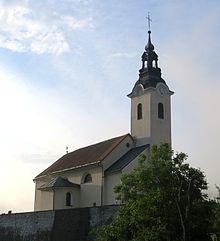Nevlje
Nevlje | |
|---|---|
 | |
| Coordinates: 46°13′52.85″N 14°37′32.07″E / 46.2313472°N 14.6255750°E | |
| Country | |
| Traditional region | Upper Carniola |
| Statistical region | Central Slovenia |
| Municipality | Kamnik |
| Area | |
• Total | 0.38 km2 (0.15 sq mi) |
| Elevation | 388.8 m (1,275.6 ft) |
| Population (2002) | |
• Total | 225 |
| [1] | |
Nevlje (pronounced [ˈneːu̯ljɛ]; German: Neul[2]) is a settlement on the Nevljica River in the Municipality of Kamnik in the Upper Carniola region of Slovenia. It is located approximately 1 kilometre (0.62 mi) from Kamnik.
Name
Nevlje was first attested in 1287 as villa de Nawel (and as Newel in 1288[3] and Newla in 1498). It is believed to be derived from the plural demonym *Nev(ь/ъ)ľane or *Neveľane. The origin of the name is unclear, but may be derived from the Slavic personal name *Neveľь, *Neveľa, or *Nevoľa.[4] Some pseudoetymologies claim that the name is related the Slovene common noun navje 'cemetery'.[5] In the past the German name was Neul.[2]
History
Nevlje is among the oldest settlements in the Kamnik area. A Negau helmet from the Hallstatt period (Early Bronze Age) was discovered in Nevlje in 1928. Kužna Hill is located above the village. Its name probably means the place where people with the plague were living.[5] In 1563, an infectious disease hospital operated in Nevlje.
Archaeological site
In March and April 1938,[6] an almost complete skeleton of a 40-year-old woolly mammoth (Mammuthus primigenius), an antler of a reindeer (Rangifer tarandus), an atlas of a polar fox (Alopex lagopus), and a small Paleolithic tool made of almost black flint were found in Nevlje by workers who built a bridge across the Nevljica and deepened its bed.[7] It was the first discovered Paleolithic hunting settlement in the territory of the present Slovenia and was dated to around 20,000 BP, the time of the Gravettian culture in the latter half of the Würm period (the last glaciation period).[7] The excavations attracted domestic and international public attention, researchers, and politicians. A bridge built at this spot was named the Mammoth Bridge (Slovene: Mamutov most).[8] A pollen analysis was performed at the site for the first time by Ana Tregubov-Budnar, the first Slovenian palinologist. In 1944, she attributed the pollen to the end of an interglacial period. Later, it was shown by Alojz Šercelj that it actually belongs to the Würm glaciation.[7] The mammoth skeleton is one of the best preserved in Europe and has become the symbol of the Natural History Museum of Slovenia, where it is now on display.[9]
Church

Saint George's Parish Church is located in Nevlje and is the oldest in the region. Until 1232, it was the seat of the Parish of Kamnik. In the middle of the 20th century, the architecture of the church was enriched by Jože Plečnik, who designed its baptistry.[10]
See also
References
- ^ Statistical Office of the Republic of Slovenia
- ^ a b Leksikon občin kraljestev in dežel zastopanih v državnem zboru, vol. 6: Kranjsko. 1906. Vienna: C. Kr. Dvorna in Državna Tiskarna, p. 28.
- ^ Slodnjak, Anton (ed.). 1955. Pogovori o jeziku in slovstvu: predavanja na zborovanju slovenskih slavistov v Mariboru od 26. junija do 1. julija 1954. Maribor: Obzorja, p. 70.
- ^ Snoj, Marko. 2009. Etimološki slovar slovenskih zemljepisnih imen. Ljubljana: Modrijan and Založba ZRC, p. 283.
- ^ a b Prostovoljno gasilsko društvo Nevlje: Zgodovina kraja Nevlja (Nevlje Volunteer Fire Department: History of Nevlje) Archived 2012-06-17 at the Wayback Machine (in Slovene)
- ^ Hribar, Nežka (November 2011). Kulturna in naravna dediščina Nevelj - terensko delo za učence drugega razreda osnovne šole v Nevljah [Cultural and Natural Heritage of Nevlje – The Terrain Work for the Pupils of the 2nd Class of the Elementary School in Nevlje] (PDF) (in Slovenian and English). Department of Class Teaching, Faculty of Education, University of Ljubljana.
- ^ a b c Brodar, Mitja (2009). Stara kamena doba v Sloveniji [Early Stone Age in Slovenia] (in Slovenian and German). ISBN 978-961-245-768-6.
- ^ "Letos mineva 70 let od najdbe mamuta" [The 70th Anniversary of the Finding of Mammoth Takes Place This Year]. Kamničan (in Slovenian). 7 December 2008. ISSN 1855-7929.[permanent dead link]
- ^ "Our Favourite Objects: Mammoth Skeleton". Natural History Museum of Slovenia. Archived from the original on 27 September 2013. Retrieved 22 May 2012.
- ^ "Krstilnica v cerkvi sv. Jurija v Nevljah" [The Baptistry in the Church of Saint George in Nevlje]. Kamra (in Slovenian). Archived from the original on 2 August 2012. Retrieved 22 May 2012.
External links
 Media related to Nevlje at Wikimedia Commons
Media related to Nevlje at Wikimedia Commons- Nevlje on Geopedia




